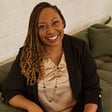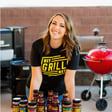Become a Creator today!Start creating today - Share your story with the world!
Start for free
00:00:00
00:00:01

Episode 49: Tayler Cusick Hollman - Creating and Organizing a Content Calendar
Tayler is the Co-Founder of Sourced Co., owner of TAYLRD Media + Designs, and formerly was the Marketing Director at Aisle Planner. As wedding industry marketing consultant, she works with wedding professionals to help them develop the skills, strategies, and stuff they need to market their businesses and build their brands.
For more resources, go to https://daveyandkrista.com/btb-tayler-hollman-episode-48/.
Transcript
Introduction to Usable Photography
00:00:05
Speaker
So when we're creating our collections of stock photography, we're very mindful that when we're shooting, we ask ourselves continually, how would someone use this photo?
Brands at Book Show with Davy Jones
00:00:20
Speaker
Welcome to the Brands at Book Show, where we help creative service-based businesses build their brands and find more clients. I'm your host, Davy Jones.
00:00:33
Speaker
Today's
Content Strategy with Taylor Cusa Coleman
00:00:33
Speaker
guest is Taylor Cusa Coleman, one of the founders of Sourceco, a styled stock solution for creatives and wedding professionals. Taylor and I chat about creating a content strategy, more specifically, building a content calendar, managing the creation process, and tips to make distribution of that content as quick as possible.
00:00:53
Speaker
Be sure to check out the show notes at davianchrista.com for the resources we mentioned during the episode, and I'd like to hear from you about what kind of content you'd like to see on the brand set book podcast as we move forward. I'd also like to know, what episodes have you enjoyed most so far and why? To leave your feedback, head on over to the Davian Christa Facebook page and send us a message. Now, on to the episode.
00:01:19
Speaker
Welcome to another episode of the Brands That Book Podcast.
Sourceco's Journey and Offerings
00:01:22
Speaker
I'm here with Taylor from Sourceco, who's getting ready to celebrate their one year business birthday. And I'm excited to dive in and talk a little bit about Sourceco. But Taylor's here to chat with us today about
00:01:35
Speaker
planning, organizing, and distributing your content. And I think that's such a valuable, it's just such a valuable topic for all of us. I know that's something even I have trouble doing, you know, just really committing to a workflow around content. So I'm excited to have you here today to chat with us about that. Yeah, I'm so excited to be here, Davey. It's been a long time since we've seen each other face to face. So I'm excited to, I know not everyone gets to join in on the video fun today, but this is an absolute pleasure.
00:02:03
Speaker
Yeah, well, I'm excited to catch up.
Transition from Isleplanner to Sourceco
00:02:06
Speaker
As Taylor just alluded to, we actually met about two years ago now at the Creative at Heart conference, but at that time you were with Isleplanner, another tech company. You all are out on the West Coast, right? Yes. We're based in San Diego.
00:02:21
Speaker
Yeah, so I'm excited to hear about your transition from I'll planner into source code kind of what all of that looked like. So tell us a little bit about how things got started. Yeah. And what I guess we should start with what source code is. I feel like I've just jumped. I've jumped ahead. So let's tell us what source code is first.
00:02:42
Speaker
Absolutely. Sourceco is a styled stock photography company. We also have a line of acrylic styling blocks. Even though when we started, we had sworn that we would never get into the physical product realm because that's a whole different beast. But when someone shows up with a really cool idea, you just kind of go for it.
00:03:02
Speaker
So the stock photography arm of the business really was the idea came from my personal. Struggles and what I was seeing on the internet, especially through my work at aisle planner. I was the former marketing director and editor in chief there and it was my job to create.
00:03:24
Speaker
an obnoxious amount of content on a daily and weekly basis. You know, being only one person with, thankfully I had the support of the most amazing copywriter, Jillian. But when you're one person and you're expected to create multiple social media posts every day, multiple blog articles every day, five days a week, your brain starts to, I think my brain has actually rewired because of the problem in trying to come up with a solution.
00:03:54
Speaker
So because of that, I just kind of kept thinking there has to be some sort of easier way to find the visuals to all of the copy that I was creating and strategizing. And
Creating Aesthetic Stock Photography
00:04:08
Speaker
there wasn't any sort of
00:04:11
Speaker
stock photography company that I could turn to that had the level of aesthetic that I was looking for for a publication and a more modern brand. So one day I just kind of started googling some things. It's like, does this exist? And it didn't really exist on any sort of scale specifically in the wedding industry. So from that point, I was like,
00:04:37
Speaker
Okay, who can I do this with because I'm a marketing professional. I'm not a photographer or, you know, like a stylist by experience. And so I rounded up a team and we started working on it while I was still at aisle planner. So it was, you know, that behind the scenes project that I think most of us start with, with hopes of growing it into something. And after about six months,
00:05:07
Speaker
I will not six months six months after our launch I really felt like it was time for me to take that leap of faith that most small business owners take at some point where it's like
00:05:20
Speaker
This isn't going to be a side project. This is going to be the thing that I'm working on. So that was what prompted my resignation over at aisle planner this past fall was because I just knew in my heart of hearts that if I wanted source code to be all the things that it could be and help people in all the ways that it can, that I needed to give it my full effort.
00:05:44
Speaker
Yeah, and I think that's a long and short of it. Yeah, and that's always such a tough decision, right? You know, because on one hand, you have some security in staying where you are, you know, and we can always kind of mentally jump through those hoops thinking and justifying, well, you know, I'm gonna stick with this and I can make time and all these other places to work on this new project.
00:06:05
Speaker
But by actually jumping into something fully and devoting all of your time to it, you can scale it in a way that's just not possible doing doing anything else. How did you go about kind of making that decision? Like,
Full-time Focus on Sourceco
00:06:16
Speaker
okay, now is the right time? Like, was there any sort of marker you hit where you're like, you know, I think I really think this can scale if I just gave it more attention. Mm hmm. I don't think that there was a specific incident. Sure. But it really was me taking a step back and having
00:06:33
Speaker
an honest conversation with myself because I had, you know, I was one of the first people to join the aisle planner team and it was, it was a couple of years old when I did, but it was still a baby business in terms of, you know, the number of wedding professionals that were using the platform. So being a baby business, I basically had, I had the challenge of growing a brand with no budget and over, you know, my three and a half year tenure there.
00:07:02
Speaker
I managed to do that using basically just my brain and like whatever scrappy skills I could put together. So it really was more of a, I know that I've done this before and I know what I can do when I have, when I surround myself with the right people to kind of compliment it. And so it was just like, someone's got to drive the bus and I have, you know, my three business partners are amazing women.
00:07:30
Speaker
I'll name them off at some point during our conversation. But someone needed to drive the bus and they are all basically new moms. So, and I'm the childless one. So it's like, okay, well, I'm the childless one. So this kind of needs to be my personal baby that I'm nurturing and pulling them in and giving them direction and very clear.
00:07:57
Speaker
Expectations in need so that they can still do all the things that they need to do as parents without losing their mind because they're trying to. Build a business the same time so it was more like this existential okay you guys if this is gonna be something then someone's gotta kind of just take the reins.
00:08:17
Speaker
Yeah, I think it's just always such a tough decision. Even I talk to a lot of husband and wife teams, and they're always asking, okay, well, how did you and Krista make the decision to both go full time? And I went full time a few years after Krista had gone full time with our business. And it's one of those things that at first, it's hard. And to a certain extent, there is a pay cut, right? You know, I left teaching at the time. And so we weren't at a place necessarily where, you know, we had doubled what the business was doing at the time and thus could bring me on, but figured
00:08:46
Speaker
If I jump in and I'm able to give it all of my time, then we can grow beyond that. Fortunately, that's what happened. I always admire people who make that leap just because I know how much goes into making a decision like that.
00:09:02
Speaker
Right?
Growing a Business with Content Strategies
00:09:03
Speaker
Yeah. I want to talk to you about how you saw content work for you with IELTS Planner. One thing that you said that struck me is growing a business with zero budget. I mean, that's like every entrepreneur just getting started unless you're a VC funded business. How did you use content specifically for IELTS Planner to grow your business?
00:09:27
Speaker
Yes. Or to grow that brother. Yeah, some of my girlfriends call me like a content queen at this point. And it's like, like, I seriously do think that my brain rewired itself to look at the world through a different lens. But when it comes to creating content with zero budget, it really starts with creating that content on the one piece of real estate that you actually own on the internet, which is your website. And
00:09:56
Speaker
Subsequently is your blog. So I made sure to, on a monthly basis, I was actually planning out a content calendar for essentially the quarter, like each quarter at a time and being very strategic about what is the experience of a wedding professional, right? So if we're just going to talk like in the most generic terms, you know, cause there are some,
00:10:26
Speaker
geographic areas where their peaks and valleys are at different times, like when you live in Arizona, your busy season is not this summer, which is everybody else's busy season. So it's very intentional in thinking, okay, well, what are people's actual mental capacity to consume information at different points of the year? And then what are the points in the calendar where they are very actively working on their business?
00:10:55
Speaker
So for wedding professionals, it's actually a pretty compressed timeline because you jump straight from busy season in the summer and early fall into booking season. So it's like essentially you have the month of October to get everything together in between your last wedding, which, you know, some people, especially here in San Diego, people are planning weddings year round. Sure.
00:11:21
Speaker
But to catch the professionals in that window of, okay, this is when they're actively seeking out information. So that's when I know I need to produce the type of information that's really going to hook them as well as provide them with actionable tools. So for any business, you know, your customer has a cycle throughout the year. So.
00:11:45
Speaker
making sure that that is mapped out, and that you can appropriately create the type of content that they either have the capacity to consume or the need for. So once I had that all planned out, it was cranking out the like holding myself accountable to actually doing it. And
00:12:05
Speaker
It's easier to hold yourself accountable when someone else is holding you accountable, right? Sure. I'm 100% guilty of, I mean, I just pushed a blog post off for source last week because I had a huge opportunity come up that it was like, this has to get done. And this blog post can wait. So no one is perfect. But you have to hold yourself accountable to it. Like, this is, by definition, like, you know, these are the things that we need to do.
00:12:33
Speaker
And then from there, it was breaking up that blog post into reusable pieces because that takes a little bit more time, but it's not an exponential amount of time because you're not recreating something for Facebook, Instagram, Instagram stories, Pinterest, you know, whatever distribution channels you have. You're not creating a piece of content from scratch. Then you're pulling something apart that you've already done.
00:13:03
Speaker
And then that way it becomes a quicker process. And that was the only way that I was able to produce that kind of content on that scale being a single person. Sure. Yeah. So the kind of content that you were mostly creating was blog content. So mostly written content. And you tried to create that content according to sort of your customer's journey or what their business cycle looked like.
00:13:31
Speaker
And again, I think that can be a little bit challenging, especially for wedding professionals, like you said, here in Maryland, wedding season is in full gear in October, you know, but in November, it probably starts to slow down. And then I'd say December, January, February, typically, slower months, you know, not for everybody, but I would say just in general, slower months. What's interesting, what I find interesting about that is, you know, website design company is that we often have, that's often our busy season, right? Because people's wedding season ends, but it's also booking season for them.
00:14:01
Speaker
So I always tell people, especially as I talk to them in the spring and summer months, now's actually a great time to work on your website because then your website will be ready by booking season instead of working on it throughout booking season. Anyways, that's a whole another conversation. Over here, no one can see me vigorously shaking my head, but I agree with that. So how important has content been in both building Isle Planner and Sourceco?
00:14:29
Speaker
Yes. So it's been terribly important. And when we talk about building content, you really can't have this conversation without talking about search engine optimization. Sure. Because, you know, I've started saying if it's not optimized, it's not worth it. Like quite literally, it's a very harsh thing to say. But
00:14:48
Speaker
There is no point in just creating content for creating content sake. It really needs to do something for you and for your business. But every business owner should know these are the keywords that are the big fish for my business. And so when you're writing blog posts, you're doing it with your keywords in mind, which means you're optimizing the URLs.
00:15:14
Speaker
which, you know, in the grand scheme of things, we're all trying to just amass this mountain of keyworded domains.
00:15:24
Speaker
So, and I'm forgetting what the original question was as I'm going down the SEO rabbit hole. Yeah, just talking about how important content is. Oh, that's right. I mean, I agree with you. And I mean, obviously, SEO is something that we do as well, and it's something that I was just talking about at the Hybrid Collective conference this past week. But even something else you said a little bit earlier about creating reusable pieces of content from that piece of content, I think goes along the same lines.
00:15:53
Speaker
Instead of just creating content for content's sake and one mistake that I think I see people make that I'm really passionate about telling people to correct is once you create a piece of content, you can reuse that content. You can reshare it. Hopefully you did your keyword research and it's optimized for search engines so people stumble upon it later doing their own research. But I think people spend hours blogging.
00:16:17
Speaker
share it once, don't love the results from that, and then they stop blogging. Yep. So when you're optimizing your content, then it has that dual purpose of being the visual hook, but also having the technological left hook that you need it to have. So because it doesn't take as much
00:16:41
Speaker
money to produce a blog post that's optimized as it would be to run even a social media ad with, you know, any sort of budget, it becomes a very important part of like a gorilla style marketing strategy. Sure. So even with sourced, especially with aisle planner, when you have no money to bill or, you know, to actually do something with like, because getting yourself to conferences is expensive.
00:17:11
Speaker
or even sponsor opportunities can be thousands of dollars in swag or fees. This is the path of least resistance and lowest hanging fruit for business owners. So business owners don't have to do it on the same type of scale that I was doing it for IELTS Planner, because it's just not realistic, because that was my job. But it is something that every creative business owner, or small business, even if it's not a creative business,
00:17:41
Speaker
you need to prioritize it because it can have an impact if you've done your research correctly and you understand exactly who your target market is, what their needs are, how you can solve the problem, and what that niche is. Because then you're able to cut through all of the noise, which is all of our, that's everybody's problem, right? Is cutting through the noise. So once you know that, you create content that speaks specifically to that person, and then you have more qualified leads coming your way.
00:18:11
Speaker
Sure, sure. So how often would you recommend people aim to create content for their businesses? Yeah.
Effective Blogging Practices
00:18:18
Speaker
So because it freaks people out and they're like, Taylor, I don't have any time. I tell people to start with a very realistic goal of two blog posts a month. Sure. Right. Like start with that. The goal is to get to one a week.
00:18:34
Speaker
Because I think that that's still a manageable amount for someone who is either a business party of one or only has a small team. If you have someone who's more dedicated to it, then you can start looking at the multiple posts, blog articles a month. But if you can get to one a week, you're in a really solid spot.
00:18:56
Speaker
And then like we talked about, you know, you break it apart, you reshare it. You know, you don't always have to be writing fresh content or you don't always have to be sharing fresh content, right? Like presumably when you've written something and you've shared it a few months later, your audience has new sets of eyeballs. Sure.
00:19:18
Speaker
quote unquote old piece of content now is new to them. So that's how you start folding in and making your social sharing a little bit easier because then you've already done like the legwork and it's just a matter of repackaging it.
00:19:36
Speaker
Yeah, and I would say that even if it's people who've been part of your audience for a long time, often they miss things. Facebook is only going to show stuff to like 10% of your page unless it gets a ton of organic traffic, then maybe it's a little bit more than that. But very rarely am I looking at my Facebook metrics and seeing that a post has been engaged with by 100% of the thousands of people who've liked their Facebook page.
00:19:59
Speaker
Same thing with Instagram. So, I'm a big believer in that just continuing to share old content until it's no longer valuable anymore. Maybe it's out of date or whatever and then it's a good opportunity to go back and update it because you've already started with it. Also, love the advice of starting two times a month. I think that's a very realistic goal for everybody. And like you said, I think if you can get to once a week, that's even better.
00:20:23
Speaker
had an interesting conversation with Graham Cochran, who's been on the podcast before, also talking about creating content. And I can't remember if this is part of the episode or a conversation that I had, you know, podcast, right. But one thing he had said is that he was creating content 234 times a week.
00:20:40
Speaker
And what he did is, you know, he went down to three times a week. And just to see like, you know, Google Analytics traffic, like, does that really affect, you know, my overall traffic? And I guess the answer was no. And then he went down to two times a week. And then he eventually got to one time a week. And so he consistently creates content once a week, but he's noticed that
00:20:56
Speaker
There's diminishing returns in creating more than that, you know, at least for his business for a big company, I think that can churn out five new posts a week. That's great, you know, good for them. But I would agree that the sweet spot being about once a week. And that's what we do. We aim to release new content once a week. Yeah, I mean, when I was at our planner at the peak, I was overseeing six blog articles every Monday through Friday.
00:21:26
Speaker
And when it came to the professional blog, which was the space that we started with, I was we were producing
00:21:35
Speaker
for articles a week just for the professionals. And then eventually it got tailored back to two times a week. And I would mirror what your friend's experience was, is that there wasn't this exponential drop off in page views when we cut our production in half. So, you know, part of that might be because like we've really done a good job of capturing the people who were going to be, you know, returners, but
00:22:03
Speaker
If you don't have to create four articles, I mean, basically the moral of the story is you don't need to ever create four blog articles. I mean, maybe Jenna Kutcher does it and Jasmine Starr, but they've got teams of people who are cranking it out and they can handle it. But like the average business owner.
00:22:23
Speaker
doesn't need to do that. Yeah, I would agree with that. So as far as planning and organizing content go, what tips do you have for people coming up with new content and then organizing that content in a way that makes sense in a content calendar? Yep. So to start with coming up with ideas, I'm going to kick off this conversation with the biggest mistake that I see people make. Sure. And the biggest mistake that I see people make
00:22:50
Speaker
is them wanting to include all of the things in one article, right? Well, all of those things, if you're talking about three different topics, that's three different articles, right? So I know that the SEO rules are constantly in flux and currently Google really likes those ridiculously long pieces.
00:23:15
Speaker
But again, in in terms of reality, most people don't have the capacity to sit down and write a 3000 word blog post. Right. So my advice there is when you have a list of topics, really make the effort to look at each. I mean, my brain starts in like working titles as opposed to.
00:23:38
Speaker
topics, but whichever camp you're in, I look at that and I think, okay, well, these are my paragraph topics. Do any of those have like strong enough legs to stand on their own? And if they do, then I'll figure out a way to move that into a separate article and then keep, you know, the topics under an art like one title, a little bit more lightweight, but still actionable. Sure.
00:24:05
Speaker
Because anything that's heavyweight should just be its own topic, right? Sure. In an effort to get to those really long posts, there's one business that I can't actually talk about to name them that I do this copywriting for them. But they wanted to create this really long handbook, so to speak. Sure. And so what we did is we broke it up into five articles.
00:24:34
Speaker
that they could publish on their own under five different URLs, but then create a master URL and put all of that content into one. So they got the best of both worlds. They got five unique articles that are more niche, but then they could also go after the bigger fish keyword with a 3000 word blog post, right?
00:25:01
Speaker
So I mean, the kind of trick that you need to do there is when you're compiling everything, you know, the SEO gods don't want duplicative content. Sure. So you need to go in and at least, you know, make some modifications. So it's not exactly it's not just copy and paste. Sure. But that's a strategy to get the best of both worlds.
00:25:22
Speaker
I really like that because I typically write 1500 to 3000 word blog posts and it takes, I want to say that it's probably a five hour project at least for me to write a blog post. I think that's a great way maybe to cut back on the amount of time I'm spending on a weekly basis, but still get the same quality content out there in the long run. Then when it comes to how I organize everything on the back end,
00:25:50
Speaker
My favorite tool has been using Basecamp. I'm on Basecamp 2 though, which Basecamp 3 is different. I don't know if Basecamp 2 is, I don't even think you can sign up for it anymore. But whatever project management platform you're on, if it has some sort of task manager in it, I
00:26:13
Speaker
create sections where it's like what we're in May. So I have a May publishing, June publishing, July publishing, and then each task under that is the working title. And then under the working title, I keep all of, you know, like that's where I'm going to put my outline. If I happen to have the luxury of pulling in Jillian, my copywriter onto it, like she, all of our communication is happening under that thread.
00:26:42
Speaker
You know, file sharing happens there too. So it keeps everything self-contained as opposed to in an email thread. So that's typically been how I organize stuff. And I know that there are fancier ways of doing it, but to me, they've been more complicated. And I'm like, I may keep it simple, stupid kind of girl.
00:27:05
Speaker
Cuz once it gets complicated, that's how people's brains start shutting down because it feels like it's a bigger thing that it actually needs to be. Yeah. So, you know, like you can for anyone who uses aisle planner, you could customize sections of your checklist, you know, if you've got a project that's specifically about your business.
00:27:25
Speaker
We also use Asana for, I have too many project management platforms. Hi, my name is Taylor and I use too many project management platforms. But we also do some of this in sourced. You know, when you have business partners, everybody's brain works differently. I'm the one that works for the average.
00:27:44
Speaker
All three of those platforms have been useful for documenting and organizing content, but my personal favorite has been Basecamp. I think we use CoSchedule within our WordPress blog, so it's a great WordPress tool for people who use WordPress. That allows us more
00:28:03
Speaker
from a publishing and sharing standpoint to see what's on the calendar and then we use ClickUp which is similar to Asana in terms of overall project management for all the different projects that we have going on from website projects to brand SEO and so on and so forth. But probably pretty similar to how you use Asana. Yeah, I mean the bottom line is that
00:28:27
Speaker
If you don't put it down on paper, even if it's electronic paper and sign a deadline to it, you're not very likely to actually complete it. So that's why whatever project management system you have, even if it's a piece of paper that you have taped up on your wall, put dates to things because that's the only way you can plan accordingly. Sure. So whatever floats your boat, just start doing it.
00:28:56
Speaker
Yeah, absolutely. So let's talk about sharing and distributing content.
Ensuring Content Visibility and Engagement
00:29:00
Speaker
I know this is a topic that you're particularly passionate about. How do you make sure that people are seeing the content that you were producing and engaging with it? Yep. So for this conversation, I'm going to share a little bit about how we do things that sourced specifically. So whenever we launch a new collection, a whole list of things that the team works collaboratively to create and all sorts of different assets for
00:29:25
Speaker
Pinterest, Facebook, Twitter, all of the social platforms that we're on. And strategically, I know that when we share on Instagram, because that's the platform that drives the most traffic to our website, I do promote the post that announces the new collection. And I give it a budget and a four-day run rate, because that's a way that I can ensure that
00:29:55
Speaker
New eyeballs are seeing what we're doing. So there is an element of you know paid traffic. Yeah paid traffic I mean, but for something like that, I Legitimately am giving it like a $20 budget over five days, you know, you don't have to go crazy spend hundreds of dollars but one of the things that I think we all just you know sigh about is that I
00:30:22
Speaker
the social media algorithms right now are rewarding you if you're being really proactive about your own engagement. So that has been something that I've made a concerted effort to do in the last few months. And I have seen rewards from that just with now the organic traffic that we're getting or how much Instagram is letting our posts out from that we're sharing. So I don't think that there's like a magical formula for it.
00:30:52
Speaker
But those are some of the tactics that I've been employing to help get more eyeballs on our stuff. But when we do share, I am sure to make each piece of content that's being shared
00:31:08
Speaker
And these are things that, you know, like are being pulled apart from the what I call the the mother or masterpiece, which is like the blog post or landing page. You do have to make sure that what you're sharing is native to each platform. And that's another mistake that I see people make. Right. So while I am sitting here holding my hand up confessing that, you know, I do sometimes share portrait oriented images on Facebook. Sure. That's not the ideal. But sometimes that's just like the best photo.
00:31:38
Speaker
You know, making sure that you're sharing the types of images that fit the platform the best. You know, I also know that our audiences on Facebook and Instagram are very different. So I take like the bones of the caption and I'm tweaking the voice a little bit, you know, so that it's actually still speaking directly to the people who are looking at it on those platforms.
00:32:08
Speaker
Um, so if you're creating content and you're doing it in a way that is human, that's going to help you in the long run. But it is in terms of like the overall strategy, a blog post publishes and we have a version that goes out on Instagram posts. We have Instagram stories that have been designed. We have a Facebook post.
00:32:33
Speaker
We have pins that are designed, which we have a bunch of internal templates that we use for that to expedite the content creation process. I know how I typically break things up and share on Twitter. And then we actually have a page on LinkedIn as well. And that's similar to our Facebook audience. So I just kind of like copy and paste there. Sure. But that's what the web of distribution looks like for us.
00:33:02
Speaker
And like I mentioned, we have templates that we've created to make it all go quickly, as opposed to recreating the wheel every single time. Yeah, and I think having those templates in place is probably huge. I know it is for us just making sure that there were, like you said, for Pinterest, I forget what it is, two to three ratio images, the long verticals or whatever. Whereas on Facebook, we're probably using a square image, Instagram square image, IG stories, something that looks more like
00:33:31
Speaker
Pinterest, but we have templates in place so I can assign that, you know, to Krista in ClickUp, you know, which is what we use and then those images are ready for that particular blog post. Yeah. And that's why we like CoSchedule too is because CoSchedule allows us to schedule to these various platforms using those, you know, various images. Yeah.
00:33:52
Speaker
So that's been really helpful because if you try to do it, you know, afresh every single blog post, you know, that one, and especially if you're blogging once a week, it's going to add up. It's going to eat up your time. Yeah, totally. And I mean, the other thing that everyone should be familiar with
00:34:11
Speaker
is, you know, and this is not anything groundbreaking, but knowing your optimal times to post. Sure. Right. Like I kind of freakishly check our, you know, on Instagram, it's so easy because it's just like the user interface is so clean that, you know, I can just double check and remind myself because if you're not posting at those optimal times, like then again, it's kind of like not optimizing your process. So it's a very simple way.
00:34:40
Speaker
A, if someone out there that's listening to this hasn't changed their social media accounts to business accounts, you should do that because it's free and it costs them money. But it also gives you access to that. So with the bang for your buck kind of theory, you know when you have the most eyeballs in general looking at your profiles and then you can schedule accordingly.
00:35:05
Speaker
Yeah, and not to plug code schedule again, but it's nice because I can choose, you know, when to share and one of the options is best time. And so, you know, I'm assuming it uses something like machine learning to figure out, okay, this is when most of your posts are engaged with. And so that's the time that it's going to publish. And it does that per day, which is nice. So it might be different on Tuesday than it is on a Saturday.
00:35:28
Speaker
So we found that to be a really helpful tool. They did just raise their prices though. So it's getting to the point where it's like, is it worth using this tool anymore? So I do want to talk a little bit as we wrap up our conversation here, how content creators for their various businesses can use source code to help aid their content creation process.
00:35:51
Speaker
So,
Supporting Content Creators with Sourceco
00:35:51
Speaker
tell us a little bit about, again, what people can find on source code and then how they can use that or work that into their workflow. Yeah. So, as I had mentioned earlier, the reason I had the idea for this was because I had a personal need for more photos, but not just pretty photos. They needed to be functional as well.
00:36:16
Speaker
So when we're creating our collections of stock photography, we're very mindful that when we're shooting, we ask ourselves continually, how would someone use this photo? Sure, it might be the prettiest thing ever, but if it doesn't serve a purpose, then it's likely to get cut from the actual deliverables.
00:36:40
Speaker
What I'm talking about in terms of functional photography are things like having white or negative space built in so that it makes it easy for someone to drop in text for announcements or whatever else they might, advertisements and things like that. Because even the best wedding photographer might not have the right image for something like that in their portfolio because you're shooting for your client, not for your marketing needs.
00:37:10
Speaker
And your marketing needs mean negative space. Sure. So there's that. But we also are creating images that in themselves are a talking point. So.
00:37:23
Speaker
Again, based on my experience at Isle Planner in writing, I actually counted before my last day how many blog posts I published over three and a half years and it was 891 over three years. So I had I knew what the like
00:37:41
Speaker
The big the conversations that I never got to have because I didn't have like the visuals to pair with it. Sure. So the other part of what we do is OK, well, what's Taylor's internal list of blog posts that wedding pros want to write? And we're just like trying to crank those out because again, it's very difficult for wedding or creative professionals to get these types of images to talk about the business of doing their business. And then lastly,
00:38:10
Speaker
I think this is one of the big things that makes our shop and subscriptions unique is that in addition to the stock photography, we also release a collection of graphics, like repeating patterns or hand illustrated elements and watercolor washes that people can then use to use in stories or add texture and dimension on their websites.
00:38:39
Speaker
I actually just created an advertisement using one of our graphics because like 90% of the work was there. And then I just added some words and dropped in a photo. And it was like, it makes me look like I'm a designer and I'm a designer, but I could do it. So those are the things that we're really working to create for people so that, you know, that's how they shave time off of their content creation process. And also.
00:39:08
Speaker
not become as frustrated, right? Because there's an element of, you know, you should do it, you want to do it and you can partly do it, but sometimes you feel like you can't take it across the finish line because it might be too expensive to hire a graphic designer to do one project or you're like, I don't have a budget to hire a photographer to do this photo shoot, like this marketing photo shoot. So like that's,
00:39:35
Speaker
the ecosystem that we're trying, like it's really an ecosystem of resource, which is kind of why we ended up being sourced Co. We want to be the destination where people come to source things for their marketing needs and for their business. So we've also like we price things, you know,
00:39:55
Speaker
at a rate that's like, you know, for 15 bucks, you can come get the stock photo in the shop that you need. We have certain graphics that are perfectly sized for Instagram or Instagram stories. And those are like five bucks. And then subscriptions or they start at $49 to get access to an entire collection, which is usually at least 75 image and graphic files every month.
00:40:20
Speaker
Which part of me feels like we're over-delivering on that. Because no one actually can use 75 miles in a month. But we know that everyone's brain thinks differently. So we do different versions of photographic vignettes or different versions of the graphic fills so that people can choose what really speaks to them. So that's really the goal for it, is that it gives people the visuals that they need for the expertise that they want to share.
00:40:51
Speaker
and that it gives them essentially templates that they can use without having to go through the whole design and creation process themselves.
00:41:03
Speaker
Yeah, I mean, I really admire how you are taking a really holistic approach to how people create their content in creating the resources that you are creating for these content creators. So not just, hey, we want an image that looks beautiful, but this image can be used in all these different places and this is how people might use this image and this is how or these are the kinds of content that people might be creating.
00:41:26
Speaker
that's awesome how can people or how you know i guess how can people get to the shop where should they go check out source code or follow along. Yeah so you can follow along at source underscore co that's our instagram handle and our website is source code dot com.
00:41:45
Speaker
Someone already had source.co. They don't do anything without like, Oh man. But yeah, so our shop is on the website. We have the subscription options. You know, you can start a subscription, cancel it at any time. You know, we don't lock you in for stuff, but you know, if there is also the option to subscribe on an annual basis so that you get access to the entire library that we've ever created. So we've got 14 collections of styled stock.
00:42:13
Speaker
that our annual members can just pop in and pull from whenever on a monthly basis monthly subscribers get access to the current months collection but again you know forty nine dollars for seventy five or more files.
00:42:29
Speaker
You know, no one's planning any sort of styled shoot for $49 because time is worth more than $49. Sure. But yeah, so sourcecode.com and at sourced underscore code is where you can find us on the internet. And then I've kind of been bopping around in real life all over the place this year. So I'm trying to think where am I going to be next? I'm going to be at LVL Academy in North Carolina in June.
00:42:56
Speaker
And then again in November, but that'll be in Southern California. And then we'll be at show it. Oh, awesome. Well, yeah, I'll be speaking at United this year. Oh, sweet. Well, then we'll get to see each other in real life. Yep. That sounds good. Well, yeah.
00:43:15
Speaker
Yeah, thank you for your time this morning. Thank you for sharing all of your content tricks with us. I know this is a topic that people just struggle creating content. There are so many different pieces to it that we've discussed today, but I think it really is
00:43:30
Speaker
one of the most important things that you can do for your business because really, I think it's the primary way that you show your competent and that you're good at what you do, that you establish yourself as an expert. I really appreciate your time. I will include a link to all of those, to the Instagram, to the website, all of that in the show notes. If you're listening, you're driving, you're running, whatever you're doing, you can just go to the show notes and then you can click over to sourcecode.com. Thanks again, Taylor. Thank you so much for having me, Davey.
00:44:02
Speaker
Thanks for tuning into the Brands That Book Show. If you enjoyed this episode, please consider subscribing and leaving a review in iTunes. For show notes and other resources, head on over to dvandchrista.com.
















